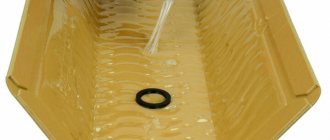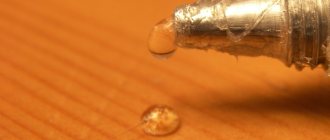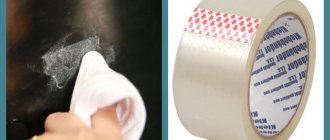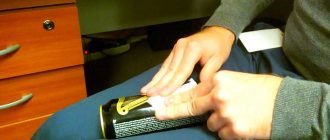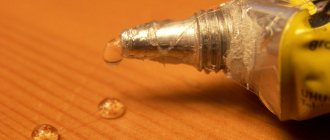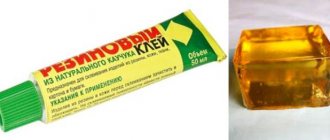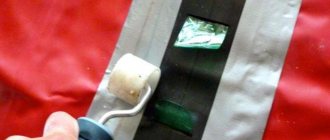Moment glue, which is produced on the basis of cyanoacrylate, is very often used by us in everyday life. And no one is safe from getting it on the laminated coating. And given the fact that this composition hardens almost instantly, it is sometimes extremely difficult to wipe it off. After all, you want to clean off the glue and not damage the surface of the flooring. And you will have to figure out how to remove superglue from the surface of the laminate without unpleasant consequences.
Process for removing superglue from laminate flooring
General information
Glue CA500-200 (Cosmofen SA-12) in original packaging
Superglue may have different names, but in any case it contains cyanoacrylate
. This must be reflected on the label. The substance has a fairly strong odor and is difficult to confuse with anything else.
When it hits the surface of laminate or linoleum, it hardens, turning first into a transparent and then into a whitish coating.
The final hardening of the glue occurs within several hours.
Glue deposits on the laminate surface
Removing such plaque is mechanically problematic,
That's why they use the chemical method.
There are several ways to remove superglue.
The whole question is only about the speed of removal and possible unpleasant consequences for humans.
The simplest way is to use special compounds based on polypropylene carbonate, which is a natural solvent of cyanoacrylate.
The method is good for everyone, except for one thing - polypropylene is toxic (hazard class 1), so its use is not recommended.
Another way is to use regular water.
Methyl cyanoacrylate dissolves in it, although slowly. Complete dissolution of a glue stain several centimeters in diameter occurs in about a day. This method is also unacceptable, since it is impossible to immerse the floor covering in water for such a long period of time - the laminate will simply deteriorate.
Therefore, the third method is used
It uses the drug dimexide
In fact, dimemxide does not dissolve the glue, but it does react with the outer layer of cyanoacrylate.
Spreading over the area of contact between the adhesive and the coating, it destroys the molecular bonds, which leads to the separation of the adhesive from the coating.
Let's consider the sequence of actions that need to be done,
To remove glue stains from laminate or any other flooring:
Action No. 1 Preparation of materials
Cotton pads and dimexide
1
To remove stains from the surface, you will need cotton pads and a certain amount of dimexide.
Dimexide is applied to a cotton pad
2
The cotton pad is ready. Dimexide is applied to a cotton pad. Now you can start removing the glue.
Action No. 2 Pre-treatment
Circular movements with a cotton pad over the entire surface of the adhesive spot
1
First, it is necessary to saturate the adhesive layer on the coating as much as possible with dimexide. This is done by using a cotton pad in a circular motion over the entire surface of the adhesive spot.
The surface should be cleaned of glue and dimexide residues using a rag.
2
Gradually, dimexide will begin to penetrate between the glue and the surface, and the glue stain will partially collapse and fall off. In this case, its fragments will remain on the cotton pad.
Remaining parts of glue
3
In about 1-2 minutes, from 50 to 80% of the glue will be removed, and only the most well-adhered fragments will remain on the surface.
This suggests that dimexide is not enough and it is advisable to saturate the disk with it again.
Action No. 3 Final surface cleaning
Movements with a cotton pad during final cleaning of the surface
Next, you should once again walk over the surface of the coating with a cotton pad.
In this case, the movements should not be circular, but directed along the fibers.
View of the cleaned surface without traces of glue
At this stage, removal of glue residue occurs even faster than at the previous one.
If you liked our article, please like it)
Subscribe to the channel so you don't miss anything interesting!
More photos and video content on the website
https://krrot.net
Household chemicals
How to remove superglue from the floor surface if there is no specialized product at hand at the moment? You can take advantage of the properties of universal solvents that can be found in any home. For example, every woman has acetone or nail polish remover. But this product is particularly aggressive (we are talking about acetone), and it is best used for ceramic tiles or especially thick laminated coatings.
How to wipe off glue with acetone
Nail polish remover works better in this case. It is not so aggressive, but only if it is butyl acetate. To do this, it is better to wet a small piece of rag with liquid and apply it to the glue. But be prepared that you will have to do this several times.
How to clean laminate flooring from dirt and stains after renovation
Many apartment owners are interested in knowing, especially those who like to see their floors smooth and beautiful, how to wash laminate flooring after renovation so that it shines as before. To achieve the desired result, you need to follow a certain sequence of actions, since it can be difficult to wash stained laminate flooring after repair. The first step is to remove large debris from the floor. Then you should wash the laminate from construction dust, after vacuuming it, avoiding hard-to-reach places.
If you decide to use a washing vacuum cleaner, you should find out in advance how to wash laminate flooring with it, since there are some special features. The fact is that not all models of washing vacuum cleaners are suitable for this floor covering. For this purpose, you can use vacuum cleaners that do not scatter water so intensively and have special attachments for quickly collecting it. An abundance of water can cause it to get into the joints between the lamellas and cause them to swell. As a result, the floor will swell and become unsuitable for further use.
Often, after repair work, small scratches and chips remain on the laminate floor, compromising the integrity of the coating. You can cope with such aesthetic defects using wax pencils, mastic or paraffin. However, it is impossible to do this without leaving marks on the surface. First of all, you need to know how to carefully wipe off the wax remaining from wax pencils and paraffin from the laminate. This can be done in two ways:
- Mechanically, by scraping wax from the floor, for example, with a credit card. The use of sharp metal objects is out of the question. They can leave their scratches on the coating. You should also avoid cleaning products with strong solvents or abrasive particles.
- By heating the remaining paraffin or wax using an iron or a regular hair dryer. Simply blot the melted material with a paper towel and wipe the mark with a rag.
In addition to wax crayons, defects in laminate flooring are masked with mastic. For this purpose, both liquid and solid mastic compositions are used. Usually, immediately after repairing the laminate, the remaining composition is removed with a rag, but if for some reason this could not be done and the composition has dried out, then the mastic stain is removed from the laminate with a special mastic remover.
For more information on how to remove scratches and chips on laminate flooring, read the article “Removing scratches and chips on laminate flooring with your own hands.”
Although such a method of finishing premises as whitewashing is used extremely rarely today, some still whitewash the ceiling. After such repairs, they have to think about how to clean the laminate from white deposits. And it’s not at all difficult to do. It is enough to wet a cloth in water softened with vinegar or citric acid. Then wipe the floor with a well-wrung out cloth. Then rinse it in clean water and wipe the floor covering again.
By the way! It is better not to try to wash laminate flooring with plain water. Although this is possible in principle, the fight against divorce can take a long time. The water will soon become cloudy due to whitewash particles, which will lead to the formation of new stains.
Mechanical removal
How to remove super glue from laminate flooring mechanically? The most important thing is never try to pick super glue from the laminate; it is bound to the substrate at the molecular level. You will simply tear off a drop along with a piece of laminate, thereby irreversibly damaging the surface.
But there is a way, and with the help of a file, a needle file, a sharpening stone or just a nail file, you can achieve good results.
Due to the transparency of cyanoacrylate, you can gradually remove the top layers to the base, however, the main thing is not to overdo it. A thin layer of glue will remain on the floor, which will not be very noticeable, and if the stain is located where the inhabitants of the house constantly walk, it will be erased over time.
Let's summarize. The best and relatively safe way to remove glue from laminate flooring, and indeed from any other surface, is naturally specialized means - debonders, preferably using the same brand.
In any case, no matter what method you use, you need to clean the surface carefully and slowly. You should not make excessive efforts; in addition, you should scrub surfaces using cleaning agents or solvents without using abrasive materials.
What is all the repairs based on? Removing glue and tape
After the renovation, the room is pleasing to the eye. New wallpaper. Shining double-glazed windows. Laminate laid in even rows... But as soon as you come closer and take a closer look, unpleasant to the eye stains from adhesive tape on the plastic, drops of glue, and traces of double-sided tape immediately appear. The tape itself has long been removed, but the dirt remains. What to do, how to clean the glue? First you need to understand what type of surfaces need to be cleaned. After all, it’s one thing to remove residual substances from furniture, another thing to remove from laminate or plastic. It is also worth considering the type of glue itself. Here are some effective ways.
Method 1
If the surface is difficult to damage or scratch, you can cut off the remaining dried glue with a stationery knife or rub it with a metal sponge.
Method 2
If the glue is water-based , you can easily wipe off traces of it with warm water . You can add any household detergent to make it easier to remove dirt. As a rule, this is how to get rid of traces of office glue and PVA .
Method 3
Unpainted surfaces can be easily cleaned with acetone or white spirit . For example, in this way it is most often possible to rid glass (windows) of glue.
Method 4
Soda paste can be used to clean various surfaces , even upholstered furniture. You need to prepare a mixture of baking soda and water and apply it to the adhesive stain. Leave for 15 – 20 minutes. If you are concerned about the material deteriorating, try applying the prepared paste to a less visible area first. Residues are removed with warm water.
Method 5
Are you wondering how to remove glue from surfaces that do not absorb liquids ? You can use oil , vinegar or petroleum jelly . As with soda, you'll have to wait. And then wipe the surface with a soft cloth soaked in warm water. Oil works best to remove tape marks from smooth materials. True, you will have to wait about 2 hours.
Method 6
Use the product in aerosol format . For example, PROSEPT Duty Universal will help remove dried glue, traces of tape and stickers from almost any surface. The composition based on organic solvents perfectly dissolves the adhesive base, but does not damage the surface of the material. On the contrary, white plastic will shine in a new way due to the whitening effect. Motorists will also appreciate this product, as it can remove dirt from the body. The composition cleanses traces of oils, petroleum products, fats, tar, soot and markers . TESA spray, which is gentle on plastic, metal and glass surfaces, copes well with the same task.
Method 7
If you are wondering how to remove a sticker or thick tape spatula or scraper will come to the rescue . Gently pry up one edge and peel off the film.
What to do immediately after glue gets on the laminate
If you were able to immediately notice the spilled glue, that’s good. The preparation has not yet had time to harden, and you can simply blot it with a paper napkin. And after cleaning, you should wipe the stained area with a damp cloth so that no traces of glue remain.
Another way is to quickly prepare a soap solution (1-2 tablespoons of liquid soap or dish gel per 1 liter of warm water) and wash off the dirt using a sponge. The water must be wiped up immediately so as not to spoil the floor.
And when the substance has time to set and is no longer “taken” with a napkin, you can try to clean it off with something thin (not metal):
- plastic spatula;
- toothpick;
- cosmetic scraper (like gouache);
- disposable knife.
Special equipment
Most chemical solvents are quite aggressive and toxic, so always use eye and respiratory protection when working with them; in addition, the room must be well ventilated, this is important!!!
You might be interested in reading the article “How to remove superglue from your fingers.” Read here...
Let's look at each solvent in more detail from best to worst:
- debonders - a professional product based on nitromethane, the best product for removing super glue, inexpensive and widespread;
- polypropylene carbonate - perfectly dissolves cyanoacrylate, but it is highly toxic, which makes it very dangerous, especially when used indoors. If you are not an experienced chemist, it is better to bypass it; there are more gentle ways;
- acetone is moderately toxic, you need to be careful; it is very aggressive and can damage the surface, as it interacts with almost all types of dyes; in the case of laminate, it can lead to fading of the surface;
- isopropyl alcohol is non-toxic, but also ineffective, since it dissolves only the upper surface of the adhesive stain, so it will have to be scraped off, which in fact is time-consuming and labor-intensive;
- white spirit, gasoline, kerosene - have similar properties, are quite toxic and fire hazardous, removing cyanoacrylates with their help will be long and difficult.
How to remove super glue from laminate flooring
How to remove instant glue from laminate, mechanically? But there is a possibility of surface damage. Chemically? Yes, using different chemical solvents is definitely more effective and much more practical, but there is also the possibility of damaging the surface.
The most effective and relatively safe way to remove super glue from laminate flooring is certainly the use of professional means for removing glue from surfaces.
Precautions when working with superglue
At least once in their life, every person has been glued to superglue. Let's look at the basic precautions to ensure that in the future superglue sticks together only what we need:
- glue often gets on your hands during the process of fastening surfaces, when we have applied too much of it, so try to squeeze out as little of the substance as possible from the tube, then there will be less chance of getting your hands dirty with it;
- if the tip of an already open tube is clogged, the hole can be carefully re-done with a thin needle, without pressing on the tube at this moment so that the glue does not flow out;
- do not try to blow out the hole with your mouth and do not squeeze the contents forcefully towards your hands and face;
- When squeezing out the remaining glue, do not twist the tube: very often it seeps through the creases formed as a result of such twisting;
- work with glue using rubber gloves;
- Prepare your work area in advance: cover or remove all surfaces that are at risk of being dirty.
Always choose the most gentle options for cleaning surfaces from superglue. Think about the organization of your workplace in advance when using this type of glue. And then you will come out clean from this “sticky” matter.
- Author: Galina Fadeicheva
Hello!
My name is Galina. I am 30 years old. I have two higher educations. Specialty: cadastral engineer. Profession: appraiser. I am currently on maternity leave. Rate this article: (21 votes, average: 4.5 out of 5)
Composition and properties of superglue
Cyanoacrylate glue was invented in 1942 by chemist Harry Coover, but its mass production began several years later. Initially, it was planned to be used for the production of transparent polymer glasses for optical systems, but the new material turned out to be too sticky, and it was rejected.
Its ability to glue almost any material was noticed in 1958, after which cyanoacrylate glue began to be produced on an industrial scale and sold under the name cyacrine. This glue turned out to be so good that it is still used today.
The main active ingredient in its composition is cyanoacrylate. Its share is about 93%. The remaining few percent are plasticizers, fillers and stabilizing additives. Depending on the brand, the glue contains a liquid monomer: methyl-, ethyl-, or propyl cyanoacrylate.
How can you remove cosmofen glue from clothes?
"Dimexide" - a concentrate for preparing a solution for external use 99%, can be purchased at a pharmacy. Moisten a cotton swab with the solution and apply it to the dried glue. After about half an hour, a noticeable result is already visible.
Interesting materials:
How to remove a stain from silicone sealant? How to remove a pine resin stain? How to remove a superglue stain on a jacket? How to remove an old grease stain? How to remove a rust stain from a white sweater? How to remove a stain from a shirt? How to wake up a PC from hibernation? How to remove faded stains on white? How to remove sweat from a shirt? How to remove vegetable oil from jeans?



